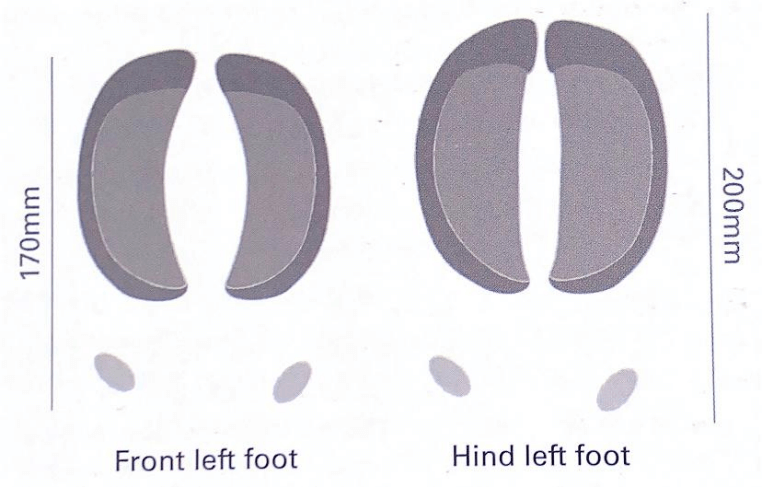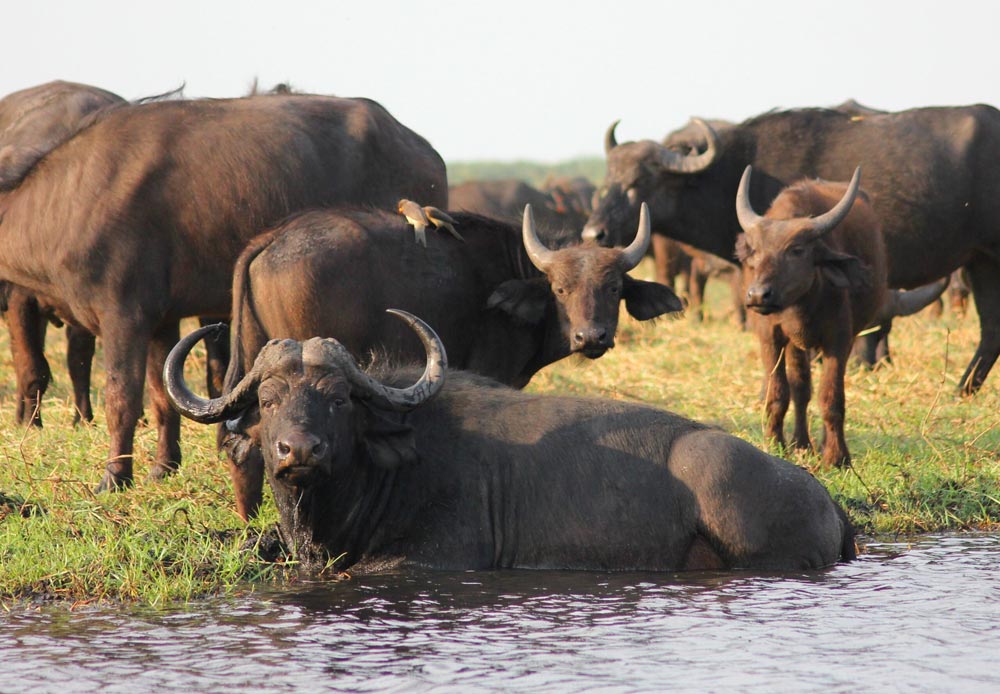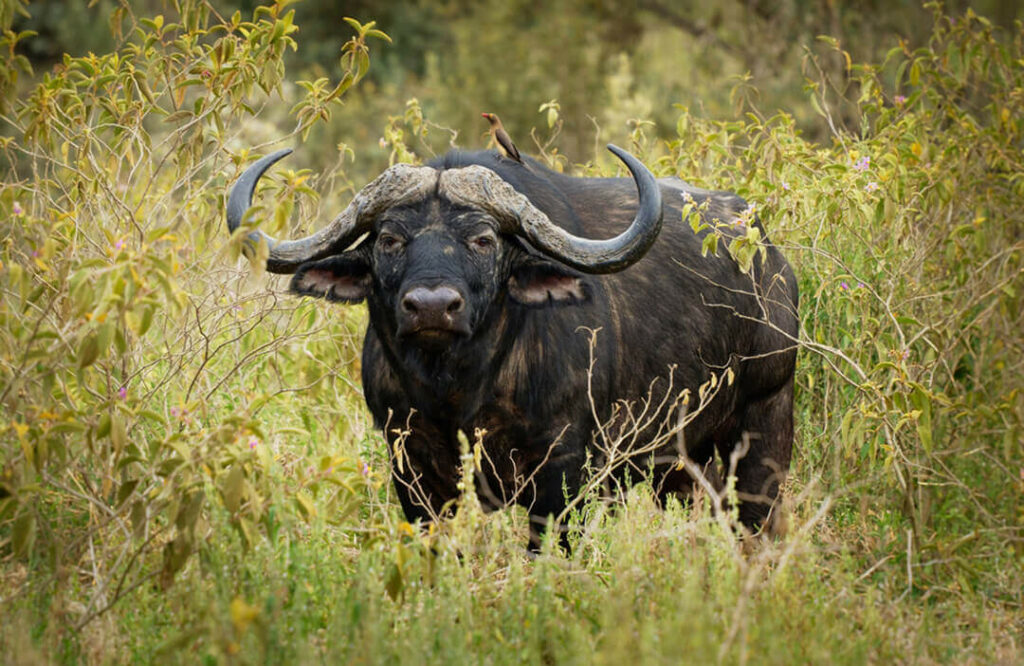[DYNAMIC-BLOGTABLEOFCONTENT]
Dugga Boys Unveiled: The Thrill of Hunting Cape Buffalo in South Africa
Dugga Boys
A dugga boy is a nickname for an old, mature male Cape buffalo. “Dugga” originates from the Zulu word for cement and Shona word for mud, as these bulls wallow in mud that dries, giving them the dugga boys nickname. Hunting one of Africa’s Big 5 and Dangerous 7, the buffalo is a force with which to be reckoned on game hunting trips to Africa! Referred to as the “widow-maker” or “black death,” these animals are sought-after for game hunting enthusiasts, eager to land a prized trophy.
Characteristics
These bulls live away from the herd, in small bachelor herds with other dugga boys, or are solitary. As they age their hair begins to fall out, which means these old Cape buffalo are exposed and vulnerable to the sun. With temperatures reaching over 100 degrees Fahrenheit in some areas, sun damage and dehydration can cause problems for these animals. However, the evolution and adaptation of these animals over millions of years has resulted in old Cape buffalo bulls rolling in any available mud. This is called wallowing and helps to regulate an animal’s temperature, acts as a protective layer from the sun, and even rids the body of any exterior parasites. These old dugga boys have smoother and harder horns than the younger bulls. They are well-honed after fighting rival bulls and working the horns in the bush for many years.
The Perfect Set of Horns
- When Cape buffalo hunting in South Africa, you will quick learn that it’s all about the horns! There are numerous attributes to a set of Cape buffalo horns that one needs to assess to determine the characteristics of the horns and what may be “perfect” horns for a Cape buffalo. We look for the following traits in trophy Cape buffalo horns:
- Width – This is the length of the horns from the outermost curve on the left to the outermost curve on the right. A nice-sized Cape buffalo would be more than 40 inches.
-
Bosses – The boss is the base of the horn where the horn connects to the skull. In mature males, this area needs to be completely hard, with no hair growing between the horns as in young, immature bulls.
-
Depth – The depth of a Cape buffalo’s horns refers to how the horns drop with a deep drop is desirable, but too deep of a drop looks overdone. The perfect drop on a set of Cape buffalo horns is required for the best set of headgear. Depth shade is often specific to what habitat and terrain the Cape buffalo may live in.
-
Points – The points of a Cape buffalo traditionally angle slightly backward. These points are the hook to the headgear, and the buffalo will use these to fling their target into the air.
-
Scrumcap – A scrumcap buffalo is when the animal has broken off both of his horns near the base of the horn, and this is a tell-tale sign of an old warrior bull. A buffalo’s horns have a foundation of bone and tissue, surrounded by the horn, a keratin formation similar to human fingernails. Breaking these horns completely off is extremely difficult to do, and a sign of true strength!
-
Horn judgment on the Cape buffalo can be a tricky challenge for the inexperienced eye when Cape buffalo hunting in South Africa. Firstly, one needs to know what the average everyday Joe kind of Cape buffalo looks like. Typically, a proper mature bull will have all of the above attributes besides a scrum cap, but his width and bosses will set him apart. The average Cape buffalo bull will have 33-38-inch-wide horns, and his bosses will be thick and full. The average ear width of a mature bull is 30 inches, so instead of judging the animal’s whole horn set, try to judge the length from the tip of the ear to the widest part of the horn on both sides. This should provide a rough estimation of size to assist during your African buffalo hunts.
Shot Placement
For your initial shot when hunting the Cape buffalo in South Africa, the heart and lungs need to be the victim of your projectile. The heart is situated low in the body and positioned slightly to the back, alongside the lungs. The heart shot is a good choice, as you hit both the lung and the heart in a single shot. Another option is to take a shoulder shot, where you will hit the buffalo 1/3 of the way up on the body, directly on the shoulder, breaking the leg and hitting the lung. This will break the buffalo’s front leg and limit its capability to run, but won’t completely stop it. For a bowhunter, a heart shot may work, but one also has the option of a brutal and direct lung shot, which provides a much larger target for the bowhunter. The headshot is always available but not recommended as it is a tiny target and would certainly not be considered an honorable way to hunt a Cape buffalo. A headshot is the backup option but is only used if the buffalo is charging and nearby.
Red – Heart shot
Pink – Shoulder shot
Blue – Lung shot
Green – Headshot
Rifles & Ammunition
It is a legal requirement in South Africa that no person may hunt a Cape buffalo with a caliber smaller than a .375. But as the saying goes, bigger is better and this applies to any hunting trip in Africa! Any large-bore bolt-action rifle will get the job done, but a double rifle is recommended. There is a certain versatility and advantage that a double rifle provides, where you can quickly shoot one shot and follow up with a second. You may aim for a heart shot first, then once the buffalo starts running, you can hit him with a second shot in the vital area. This makes a big difference in the long run, as every bullet counts. A .416 Rigby provides a punch of impact velocity, making it a great choice to hunt buffalo. A .458 Winchester Magnum or .458 Lott are a good choice too, as both of these calibers deliver a large projectile of roughly 500 grains at speeds as low as 1800 feet per second, making for a huge velocity on impact scenario. In the double rifle department, all calibers are applicable including .470, .500, .577, and .600, which are all Nitro Express designs. For the first shot an expanding monolithic bullet is ideal, one which will expand and create damage but not fall apart as a result of shooting through a bush. Follow-up and charging shots can use the same bullets and will work well. Another option of shooting a non-expanding monolithic is also available. This round will be cheaper and won’t expand as it creates a consistent tunnel through the target. This bullet is also ideal for a follow-up headshot, as it will minimize damage to the buffalo’s skull.
Tracking & Behaviour
Dugga Boys are usually found alone or in small groups, allowing the buffalo tracking to be easy or challenging, whichever way your prefer to view it on your game hunting safari. Dugga Boys are to an extent predictable and have a specific behavior they practice, which suits anyone on a Cape buffalo hunt in South Africa, as it gives them the edge on tracking the animals. All Cape buffalo are water-dependent, so they visit a watering hole at least once a day and may even drink twice a day in summer periods. Any mud pools or small water sources are a hotspot for old Dugga Boys as they like to be away from any action or potential threats while wallowing religiously in the mud. This means they also like to hide away in thick vegetation that provides a separate challenge to the hunt. But, this also means we know where to find the buffalo and how to find them. The actual track of a Cape buffalo is easy to recognize, but it can be confused with a Cape Eland. The buffalo track is wider and symmetrical at the point, where the land is slightly mismatched. The buffalo also possesses false hooves, which are little nobs on the back of the ankle, and these can easily be seen in the thick, muddy substrate. They set the Cape buffalo apart from any other animal. Dugga boys will also leave marks on trees, where they will rub and hit their horns, removing marks and scarring the tree. This shows dominance and is also a form of practice fighting. Old dugga boys will also rub their bodies against trees, and mud will then come off the tree, almost marking it. This is a golden indication of a nearby dugga boy!

Dugga Boys are usually found alone or in small groups, allowing the buffalo tracking to be easy or challenging, whichever way your prefer to view it on your game hunting safari. Dugga Boys are to an extent predictable and have a specific behavior they practice, which suits anyone on a Cape buffalo hunt in South Africa, as it gives them the edge on tracking the animals. All Cape buffalo are water-dependent, so they visit a watering hole at least once a day and may even drink twice a day in summer periods. Any mud pools or small water sources are a hotspot for old Dugga Boys as they like to be away from any action or potential threats while wallowing religiously in the mud. This means they also like to hide away in thick vegetation that provides a separate challenge to the hunt. But, this also means we know where to find the buffalo and how to find them. The actual track of a Cape buffalo is easy to recognize, but it can be confused with a Cape Eland. The buffalo track is wider and symmetrical at the point, where the land is slightly mismatched. The buffalo also possesses false hooves, which are little nobs on the back of the ankle, and these can easily be seen in the thick, muddy substrate. They set the Cape buffalo apart from any other animal. Dugga boys will also leave marks on trees, where they will rub and hit their horns, removing marks and scarring the tree. This shows dominance and is also a form of practice fighting. Old dugga boys will also rub their bodies against trees, and mud will then come off the tree, almost marking it. This is a golden indication of a nearby dugga boy!
South African Cape Buffalo
Distribution
Within South Africa, the Cape buffalo can occur in the biomes and natural terrains. They are stocked on many private game hunting farms, in areas where they may not naturally occur. This makes the species highly adaptable. They may still, however, require the occasional supplementary feeding effort. Cape buffalo are grazers by summer, where their browsing intake will increase during winter as the grass is drying out. This makes their whereabouts semi-predictable according to the season of the hunt. They are originally named the savanna buffalo, a name which they rightfully earned, as the savanna terrain is one of their favorite habitats. Buffalo will graze primarily on sweet and nutritional grasses, but as seasons and areas change, it will become more selective as to what it feeds on and will depend slightly on a leaf-based diet, if necessary. Large herds of buffalo are native to open plains and grasslands, where they move into thick vegetation in due time. Old dugga boys, either alone or in small groups, will stick to areas with low activity and thick vegetation to keep them hidden, with a nearby water source to drink from and wallow in.

Game Breeding
The game and wildlife industry in South Africa is a high-value and fast-rising industry. The biological assets that naturally roam through the country are walking gold. South Africa is one of the most species-rich and biodiverse areas on the planet, and the wildlife that calls it home provides a stable source of income for many South African farmers who arrange African buffalo hunts and other species on their land. The Cape buffalo is one of the most valuable species farmed in South Africa. They are bred to have specific characteristics represented, the same characteristics to look for in a mature dugga boy: width, depth, and bosses. These animals hold a high value according to their health status. There are numerous wildlife diseases in South Africa, and disease-free buffalo hold exceptional value as biological assets. Buffalo that have tested positive for a disease may not be moved from that area while alive, and this is to control the spread of the disease.
Value
As the Cape buffalo is such an important aspect of the game breeding industry within South Africa, their value does not go unnoticed. These animals breed in controlled environments for specific attributes to show. As these animals are bred for game hunting, they need to meet the hunter’s requirements and expectations for buffalo hunting in South Africa. Any buffalo that is bigger and better in any way will draw a higher value according to the current pricing. All aspects of the buffalo are assessed, but the width of the horns is the driving factor in the price determination of the animals:
• 36”= $4 000
• 40”= $6 000
• 42”= $7 000
• 45”= $10 000
• 47”= $13 000
• 48”= $26 000
• 49”= $40 000
• 50”= $52 000
Females & Calves
Day 3 started two-fold: First, we realized this was our last day of hunting, as we had only allocated three full days to this challenge. Secondly, I realized to my dismay, that I had made a terrible mistake! I had invested so much time and energy into load development, training Tamlyn on the 500 NE, and packing provisions that I had forgotten to protect against a little pest! The pepper tick! I had bites all over my legs, around the belt area, my back and arms, and a few places where it would not be prudent to mention…
Around 07:30 we came across the tracks of what seemed to be a big Cape buffalo. We followed for about an hour before the professional hunter and Tamlyn spotted him about 50 yards out, resting in the shade behind some Acacia bushes. At this point, I stayed far behind because the GoPro kept making all these beeping noises, and I had no idea how to silence it! I was having a rather miserable morning between the beeping GoPro and the tick bites!
Buffalo hunting in Africa
South Africa remains the top destination for African buffalo hunts.
If your next game hunting safari needs to tick the boxes for adrenaline, action, and pure excitement, then Cape Buffalo hunting in Africa is the way to go! Click here for information and our latest Cape Buffalo Hunting Safari packages.


